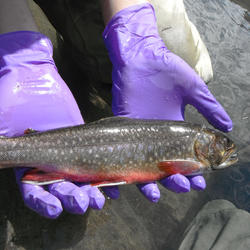Efficacy of Eggshell Analyses as a Nonlethal Method to Estimate Mercury Exposure in Bird Embryos
White-Faced Ibis and Gulls
U.S. Geological Survey (USGS) scientists evaluated a nonlethal method to estimate mercury in the embryos of 23 bird species using mercury content in eggshells. This method was effective for a wide range of ages and species.
Avian ecotoxicologists often examine contaminant bioaccumulation in different bird tissues with the intent of relating tissue concentrations to established toxicological benchmarks to understand the risks of potential adverse health effects. Bird eggs are an ideal matrix for measuring environmental contaminants because they reflect parental exposure and can be directly linked to reproductive effects. Sampling eggshells after chicks hatch could provide a nonlethal method for assessing contaminant exposure and risk to reproduction.

Mercury is a globally pervasive contaminant that has been reported to impair the reproductive health of fish and wildlife, yet few studies have evaluated the utility of eggshells as a sampling tissue to estimate bird exposure to mercury. Scientists collected eggs from 23 bird species at several locations around the Great Salt Lake, in northern Utah, for this study. This location was selected because mercury has been documented in the water, sediment, and biota in the wetlands of the Great Salt Lake ecosystem which is known as an important breeding, migratory, and wintering habitat for millions of waterbirds. They measured mercury concentrations in the eggshell components (specifically hardened eggshells, material adhered to the eggshells, and inner eggshell membranes) and the egg contents.
The relation between mercury concentrations in eggshell components and egg content (embyo) concentrations was significant for each eggshell component. Mercury concentrations in eggshells were much lower than in the other eggshell components and much lower than in embryos. Despite very little mercury in eggshells, mercury concentrations in eggshells had the strongest correlation with mercury contents in embryos among all eggshell components.
Overall, this study concludes that the nonlethal method of measuring mercury in eggshells can be used to estimate mercury concentrations in embryos if age and species are addressed in the sampling design and if consistency in eggshell processing is utilized. This study is part of a long-term goal of the USGS Environmental Health Program to understand and inform land and resource management efforts to minimize exposure and the health risks of organisms exposed to pervasive contaminants.
This research was supported by the USGS's Contaminant Biology Program, U.S. Fish and Wildlife Service's Environmental Contaminants Program, and the Utah Department of Environmental Quality's Division of Water Quality.
Below are other science teams and laboratories associated with this work.
Ecologically-Driven Exposure Pathways Science Team
Synthesis of Mercury Distribution and Bioaccumulation Across Western North America
Western Ecological Research Center
North American and European Atmospheric Mercury Declines Explained by Local and Regional Emission Reductions
Mercury in Fish from 21 National Parks in the West
Below are publications associated with this Activities and Expertise.
A critical evaluation of the utility of eggshells for estimating mercury concentrations in avian eggs
Mercury and selenium contamination in waterbird eggs and risk to avian reproduction at Great Salt Lake, Utah
U.S. Geological Survey (USGS) scientists evaluated a nonlethal method to estimate mercury in the embryos of 23 bird species using mercury content in eggshells. This method was effective for a wide range of ages and species.
Avian ecotoxicologists often examine contaminant bioaccumulation in different bird tissues with the intent of relating tissue concentrations to established toxicological benchmarks to understand the risks of potential adverse health effects. Bird eggs are an ideal matrix for measuring environmental contaminants because they reflect parental exposure and can be directly linked to reproductive effects. Sampling eggshells after chicks hatch could provide a nonlethal method for assessing contaminant exposure and risk to reproduction.

Mercury is a globally pervasive contaminant that has been reported to impair the reproductive health of fish and wildlife, yet few studies have evaluated the utility of eggshells as a sampling tissue to estimate bird exposure to mercury. Scientists collected eggs from 23 bird species at several locations around the Great Salt Lake, in northern Utah, for this study. This location was selected because mercury has been documented in the water, sediment, and biota in the wetlands of the Great Salt Lake ecosystem which is known as an important breeding, migratory, and wintering habitat for millions of waterbirds. They measured mercury concentrations in the eggshell components (specifically hardened eggshells, material adhered to the eggshells, and inner eggshell membranes) and the egg contents.
The relation between mercury concentrations in eggshell components and egg content (embyo) concentrations was significant for each eggshell component. Mercury concentrations in eggshells were much lower than in the other eggshell components and much lower than in embryos. Despite very little mercury in eggshells, mercury concentrations in eggshells had the strongest correlation with mercury contents in embryos among all eggshell components.
Overall, this study concludes that the nonlethal method of measuring mercury in eggshells can be used to estimate mercury concentrations in embryos if age and species are addressed in the sampling design and if consistency in eggshell processing is utilized. This study is part of a long-term goal of the USGS Environmental Health Program to understand and inform land and resource management efforts to minimize exposure and the health risks of organisms exposed to pervasive contaminants.
This research was supported by the USGS's Contaminant Biology Program, U.S. Fish and Wildlife Service's Environmental Contaminants Program, and the Utah Department of Environmental Quality's Division of Water Quality.
Below are other science teams and laboratories associated with this work.
Ecologically-Driven Exposure Pathways Science Team
Synthesis of Mercury Distribution and Bioaccumulation Across Western North America
Western Ecological Research Center
North American and European Atmospheric Mercury Declines Explained by Local and Regional Emission Reductions
Mercury in Fish from 21 National Parks in the West
Below are publications associated with this Activities and Expertise.






